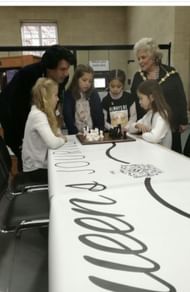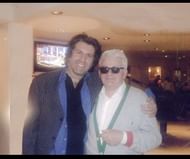Jason Kouchak is a performer who uses chess and art to encourage more children to take up the game and enjoy its beauty. Although he is a musician, he played chess himself from a young age, and the sheer amount of passion for both these subjects drew him to establish the Queen's Journey.
The Queen's Journey is a program established by Kouchak to increase the number of women and girls playing chess. The aim of the initiative is to use music, ballet, and chess to educate and entertain on equal levels. The concept also alludes to the power of chess as a logical and analytical tool to improve the life skills of its players.
It adopts different themes due to its three-fold nature with chess, ballet, and music to stay relevant for multiple events. Examples of such topics are "Power and Grace", "Chess Connects", and "Empowerment".
In this interview, we find out more about what this program is all about, other chess and art projects, and more. So, let's move onto the Q/A now.
1. Can you tell us a bit about yourself?
My name is Jason Kouchak, I am a French pianist, composer, singer-songwriter, choreographer, and creative director.
2. What drew you to chess? Share your early memories of the game.
I first started playing chess with both my parents when I was 5 years old during the same time I started my piano lessons. I enjoyed watching my mother defeat my father sometimes. She was 'the queen' in our family.
3. How did you start the Chess Ballet program? What was the idea behind launching this initiative?
I had already directed a chess ballet production at the British Museum in 2015 and in the same year I established the ‘Queen’s Journey' to encourage more women and girls to play chess. I realised that through music, ballet, and chess, the Queen’s Journey could be a valid concept to entertain and educate the future generations of 'Queens'.
In 2016, my chess ballet theme was ‘Power and Grace’ to mark HM Queen Elizabeth’s 64-year reign, which was performed in New York with Hikaru Nakamura’s mother Carolyn playing the violin. My music and chess ballet was also included at Judit Polgar’s festivals at Budapest in 2017 and 2018.
In 2019, I was a special guest at the Altibox Norway Chess, performing the chess ballet world premiere ‘Queen of the Knight’.
I also bought three giant chess sets ‘LEaP’ in London, Edinburgh, and Paris as a positive message and mission statement for chess players to move forward together in the future.

4. In your opinion, what is the meaning of chess in its truest form?
Chess is a journey, a process of looking ahead and searching for your own road to the truth. In essence, our ability to find order in the co-ordination and movement of our pieces. Our power to visualise by observing, assessing, and evaluating our position on a chessboard allows us to manage our time, energy, and space in order to reach our end objectives.
5. You also worked with the Judit Polgar Chess Festival. Give us more details on this.
It was a pleasure and a privilege to work with Judit Polgar in 2017 and 2018 to connect chess and music as an Ambassador of Artistic Values.
Queen's Journey was showcased in Budapest with the performance idea of poise, pace, positive projection, precision and power as we combined our resources to educate more children about the beauty of chess through music and dance.
6. Talk more about chess as an art. What does this mean to you personally?
For me personally, chess as an art is the ability to resolve creative or complicated positions by searching and hopefully finding harmony on the chessboard. As in music, the space between the notes can be as important as the notes themselves. The art of co-ordination is to let the chess pieces sing together in unison. Also, the beautiful concepts of realignment, changing key, transposing positions, chord progressions, and holding space are parallel in both chess and music.
7. You have also worked on designing boards and pieces including a 3D printed set. What was this about?
I wanted children specifically to be able to use cutting-edge technology to create chess pieces. The process of designing and formulating a new way of producing pieces inspired them to use their talent and creativity in a new dimension.
8. Recall the journey that you took with the Alice Chessboard.
I created the Alice Chessboard and ballet as a tribute to the drawings of illustrator Sir John Tenniel.
‘Through the Looking Glass’ is Alice’s journey moving forward across the chessboard from girl to the Queen. The name of the ballet is ‘VisuAlisation’ 20/20 as this is the essence of the story and her journey.
This was to be performed in 2020 at the V and A (Victoria and Albert) Museum in London, but it is now scheduled for Spring 2021.
9. What are your near future goals?
I would like to inspire more children and specifically 'Queens' to play chess by staging more chess ballet shows and productions with the ‘Queen's Journey’. I have already written a new chess tango song to be staged in Paris, hopefully in 2021. I am also aspiring to create a new ‘movement’ of giant chess sets to inspire more people to play chess as an art form and to encourage communal spirit.
10. Where do you hope to see the game progress towards?
I would like more children to play chess worldwide and hope chess as a game can help us embrace our differences and move forward, especially during these challenging times. I hope that chess and and music together can be an opportunity to find harmony and healing in humanity.
11. What have been some of your greatest memories from chess?
There are three chess and music stories:
I remember the final day of the Women vs Veterans at the London Hilton in 1996 and we celebrated a great tournament at the Hilton rooftop, which happened to have a grand piano. I had the honour of playing the piano with Smyslov, Taimonov and Portisch on an evening (with three distinguished knights) that I will always remember.
My friend, James Plaskett, invited me to the BBC White City studios to meet Kasparov during a lunch break from filming in 2000. When I presented him with one of my CD’s called ‘Watercolours’, Kasparov smiled and told me that he was surprised that I had written a song called ‘Deep Blue’. I hadn’t the heart to say it was a coincidence!
In 2009, I played at the wonderful Gibraltar chess tournament organised by Stuart Conquest. He kindly introduced me to Boris Spassky who told me that he would only remove his sunglasses if I played his favourite Rachmaninov 2nd piano concerto on the piano just behind us at the Caleta Hotel. I played a small excerpt and then the three of us spent the rest of the evening together.

12. Finally, what advice would you give to our readers?
I hope that people can always find a framework to ‘believe’ in their position in life. In both music and chess, there is always a chance to win from even an initially lost position. This ability to recover and visualise comes from our core values, which helps us to believe in ourselves and look forward to the future.